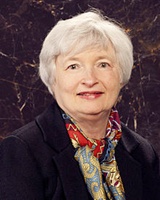US Federal Reserve leaves monetary policy unchanged
31 Jul 2014
The Federal Open Market Committee of the Federal Reserve at its meeting on Wednesday decided to keep the pace of reduction in its monthly purchases of government bonds to $25 billion from the $35 billion level set at the central bank's last meeting in June.
 Beginning in August, the Federal Reserve will add to its holdings of agency mortgage-backed securities at a pace of $10 billion per month rather than $15 billion per month, and will add to its holdings of longer-term Treasury securities at a pace of $15 billion per month rather than $20 billion per month, the FOMC said in a release.
Beginning in August, the Federal Reserve will add to its holdings of agency mortgage-backed securities at a pace of $10 billion per month rather than $15 billion per month, and will add to its holdings of longer-term Treasury securities at a pace of $15 billion per month rather than $20 billion per month, the FOMC said in a release.
But the US central bank decided to keep holding its base interest rate near zero, despite a surprisingly strong second-quarter economic growth report.
The ongoing reduction in monthly purchases, launched in January, will taper by the end of the year. Until January this year, the Fed had been buying $85 billion of bonds every month.
The Fed noted that economic activity had rebounded in the second quarter and labour conditions improved, even as ''there remains a significant under-utilisation of labour resources.'' It also said household and business spending was improving, but recovery in the housing sector remained slow.
''In light of the cumulative progress toward maximum employment and the improvement in the outlook for labour market conditions since the inception of the current asset purchase programme, the committee decided to make a further measured reduction in the pace of its asset purchases,'' the Fed said in a statement.
''To support continued progress toward maximum employment and price stability, the Committee today reaffirmed its view that a highly accommodative stance of monetary policy remains appropriate. In determining how long to maintain the current 0 to 1/4 per cent target range for the federal funds rate, the Committee will assess progress--both realised and expected--toward its objectives of maximum employment and 2 per cent inflation'', FOMC stated in its release.
The Fed committee said on the basis of its assessment of information, including measures of labor market conditions, indicators of inflation pressures and inflation expectations, and readings on financial developments, it anticipates it would be appropriate to maintain the current target range for the federal funds rate for a considerable time after the asset purchase programme ends.
The US economy grew at an annual rate of 4 per cent in the second quarter, the Bureau of Economic Analysis said earlier Wednesday. The figure marks a turnaround after gross domestic product registered its first decline in three years in the previous quarter.
The Fed left its benchmark interest rate unchanged at the unprecedented, near-zero level in place since December 2008.
The Fed started the current round of quantitative easing in September 2012 at $85 billion a month - an annual pace of $1 trillion stimulus to the nearly $17 trillion US economy.
The bond purchases was meant to push investment into the private economy at a time when the Fed felt it had to act to spur US growth and fend-off the spectre of deflation. This, however, triggered volatile investment flows into developing economies with higher growth rates.



.webp)
.webp)

.webp)
.webp)

























